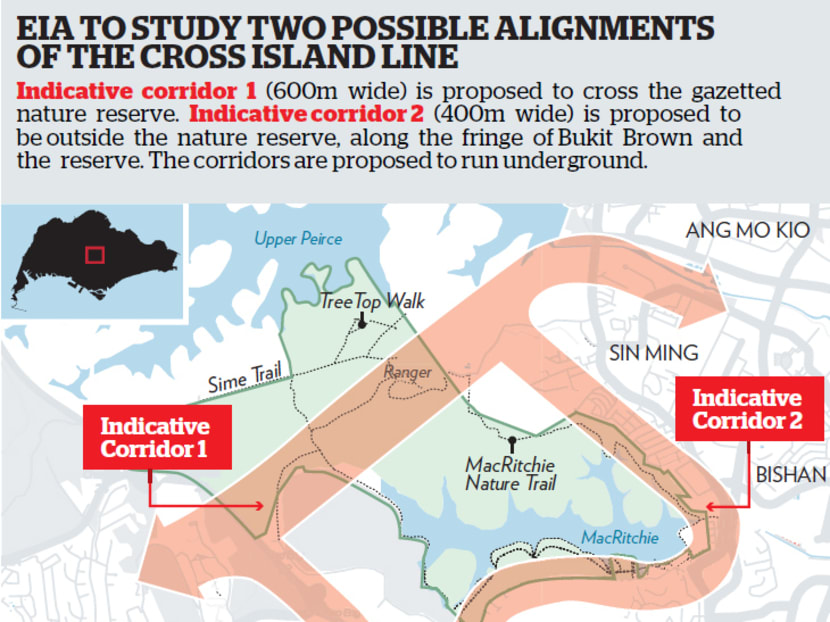LTA calls tender to evaluate Cross Island Line’s impact on nature
SINGAPORE — To assess the potential environmental impact of the Cross Island Line (CRL), a baseline evaluation on its two possible alignments, through or around the Central Catchment Nature Reserve (CCNR), will first be conducted to determine the existing eco-system and physical conditions.
SINGAPORE — To assess the potential environmental impact of the Cross Island Line (CRL), a baseline evaluation on its two possible alignments, through or around the Central Catchment Nature Reserve (CCNR), will first be conducted to determine the existing eco-system and physical conditions.
The evaluation will form the first phase of the Environmental Impact Assessment (EIA), for which the Land Transport Authority (LTA) called a tender yesterday to assist the Government in making a considered decision on the alignment of the 50km line.
Connectivity, travel times, costs and land-use compatibility are other factors under consideration, said the LTA.
After the first phase is concluded, the consultant will be required to provide an assessment of the impact that may result from the construction and operation of the line.
It will also need to propose guidelines and recommend appropriate mitigating measures, so activities carried out will have minimal impact on the nature reserve.
The consultant’s report, which is slated to be completed in the second quarter of 2016, may be gazetted for public disclosure.
Noting that Singapore has a long-standing commitment to environment sustainability, Senior Minister of State (Transport) Josephine Teo said an EIA of this scale is a first for rail development here.
In a Facebook post, she said: “An EIA of this scale is new for rail development and is necessary because the CCNR is special. In land-scarce Singapore, its very existence is testament to the high value placed on preserving nature even as we develop.”
The announcement of the 50km-long CRL, which will connect Jurong to Changi when it is completed in 2030, drew much consternation from nature and environment groups when it was announced in January last year.
The groups have raised concern that the alignment of the CRL, as well as the work to construct it, will have a detrimental environmental impact on the CCNR — a gazetted reserve under the Parks and Trees Act.
Members of the Nature Society Singapore (NSS) and the Cicada Tree Eco-Place submitted an ecological study of the reserve to call for the forest area to be protected.
However, their proposed alternative route, which goes around the southern part of the reserve, has raised concern from some residents in the Thomson area that their homes may be affected.
The area’s Member of Parliament Hri Kumar said the chairpersons of these private estates from Yew Lian Park to Windsor Park had a meeting with the LTA late last year to express concerns about land acquisition and disruptions due to construction work, if the CRL was to be diverted close to their estates.
Mrs Teo yesterday stressed that no soil survey or other physical work would be conducted within the reserve before the consultant provides its recommendations.
Addressing concern that the EIA might lead to a delay in the construction of the line, Mrs Teo added that the LTA would be calling a tender for a study on engineering feasibility of the line along stretches outside the nature reserve.
To commence in the second half of this year, the engineering study is expected to be completed in 2016.
Said Mrs Teo: “It will be a few years before we can finalise the CRL alignment and start construction. But the intent is clear — we must press forward to develop more rail lines because mass rapid transit is, in fact, the most environmentally sustainable way to achieve high-quality mobility for Singaporeans. Equally important is care for nature as we develop.”
Mr Tony O’Dempsey, the NSS spokesperson on the issue, said the group would provide input to the EIA as technical adviser and reviewer of the study.
He added: “We look forward to a report that provides a comprehensive assessment of the total biodiversity in the project areas, as well as a realistic assessment of the potential impact on the natural environment due to soil investigation and construction activity.”







